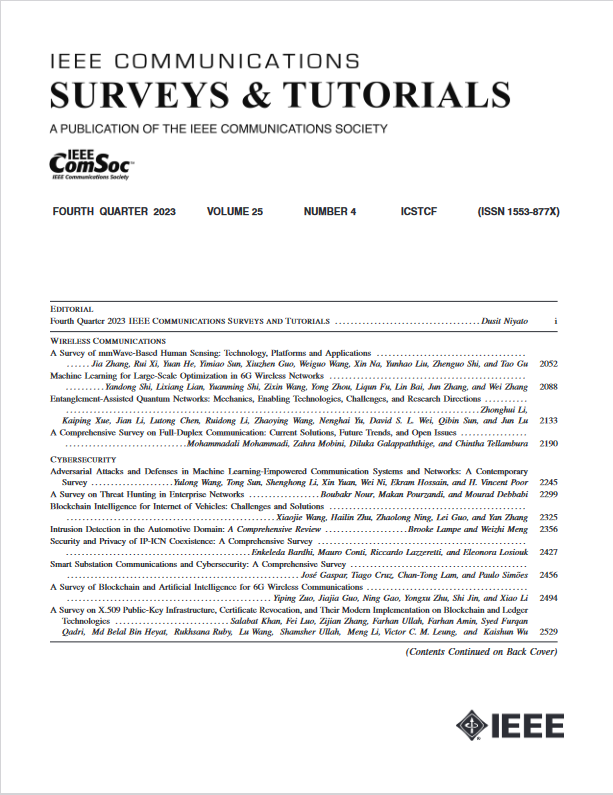Digital Twins: A Survey on Enabling Technologies, Challenges, Trends and Future Prospects
IF 34.4
1区 计算机科学
Q1 COMPUTER SCIENCE, INFORMATION SYSTEMS
引用次数: 106
Abstract
Digital Twin (DT) is an emerging technology surrounded by many promises, and potentials to reshape the future of industries and society overall. A DT is a system-of-systems which goes far beyond the traditional computer-based simulations and analysis. It is a replication of all the elements, processes, dynamics, and firmware of a physical system into a digital counterpart. The two systems (physical and digital) exist side by side, sharing all the inputs and operations using real-time data communications and information transfer. With the incorporation of Internet of Things (IoT), Artificial Intelligence (AI), 3D models, next generation mobile communications (5G/6G), Augmented Reality (AR), Virtual Reality (VR), distributed computing, Transfer Learning (TL), and electronic sensors, the digital/virtual counterpart of the real-world system is able to provide seamless monitoring, analysis, evaluation and predictions. The DT offers a platform for the testing and analysing of complex systems, which would be impossible in traditional simulations and modular evaluations. However, the development of this technology faces many challenges including the complexities in effective communication and data accumulation, data unavailability to train Machine Learning (ML) models, lack of processing power to support high fidelity twins, the high need for interdisciplinary collaboration, and the absence of standardized development methodologies and validation measures. Being in the early stages of development, DTs lack sufficient documentation. In this context, this survey paper aims to cover the important aspects in realization of the technology. The key enabling technologies, challenges and prospects of DTs are highlighted. The paper provides a deep insight into the technology, lists design goals and objectives, highlights design challenges and limitations across industries, discusses research and commercial developments, provides its applications and use cases, offers case studies in industry, infrastructure and healthcare, lists main service providers and stakeholders, and covers developments to date, as well as viable research dimensions for future developments in DTs.数字孪生:赋能技术、挑战、趋势和未来前景调查
数字孪生(DT)是一项新兴技术,充满了许多希望和潜力,可以重塑整个行业和社会的未来。DT是一个系统的系统,它远远超出了传统的基于计算机的模拟和分析。它是将物理系统的所有元素、过程、动态和固件复制到数字对等体中。这两个系统(物理和数字)并排存在,通过实时数据通信和信息传输共享所有输入和操作。随着物联网(IoT)、人工智能(AI)、3D模型、下一代移动通信(5G/6G)、增强现实(AR)、虚拟现实(VR)、分布式计算、迁移学习(TL)和电子传感器的结合,现实世界系统的数字/虚拟对应体能够提供无缝监控、分析、评估和预测。DT为复杂系统的测试和分析提供了一个平台,这在传统的模拟和模块化评估中是不可能的。然而,该技术的发展面临着许多挑战,包括有效通信和数据积累的复杂性,训练机器学习(ML)模型的数据不可用性,缺乏支持高保真双胞胎的处理能力,对跨学科协作的高度需求,以及缺乏标准化的开发方法和验证措施。由于处于开发的早期阶段,dt缺乏足够的文档。在此背景下,本调查论文旨在涵盖该技术实现的重要方面。重点介绍了DTs的关键使能技术、挑战和前景。本文提供了对该技术的深入了解,列出了设计目标和目的,突出了跨行业的设计挑战和限制,讨论了研究和商业开发,提供了其应用程序和用例,提供了工业、基础设施和医疗保健领域的案例研究,列出了主要服务提供商和利益相关者,并涵盖了迄今为止的发展,以及未来发展的可行研究维度。
本文章由计算机程序翻译,如有差异,请以英文原文为准。
求助全文
约1分钟内获得全文
求助全文
来源期刊

IEEE Communications Surveys and Tutorials
COMPUTER SCIENCE, INFORMATION SYSTEMS-TELECOMMUNICATIONS
CiteScore
80.20
自引率
2.50%
发文量
84
审稿时长
6 months
期刊介绍:
IEEE Communications Surveys & Tutorials is an online journal published by the IEEE Communications Society for tutorials and surveys covering all aspects of the communications field. Telecommunications technology is progressing at a rapid pace, and the IEEE Communications Society is committed to providing researchers and other professionals the information and tools to stay abreast. IEEE Communications Surveys and Tutorials focuses on integrating and adding understanding to the existing literature on communications, putting results in context. Whether searching for in-depth information about a familiar area or an introduction into a new area, IEEE Communications Surveys & Tutorials aims to be the premier source of peer-reviewed, comprehensive tutorials and surveys, and pointers to further sources. IEEE Communications Surveys & Tutorials publishes only articles exclusively written for IEEE Communications Surveys & Tutorials and go through a rigorous review process before their publication in the quarterly issues.
A tutorial article in the IEEE Communications Surveys & Tutorials should be designed to help the reader to become familiar with and learn something specific about a chosen topic. In contrast, the term survey, as applied here, is defined to mean a survey of the literature. A survey article in IEEE Communications Surveys & Tutorials should provide a comprehensive review of developments in a selected area, covering its development from its inception to its current state and beyond, and illustrating its development through liberal citations from the literature. Both tutorials and surveys should be tutorial in nature and should be written in a style comprehensible to readers outside the specialty of the article.
 求助内容:
求助内容: 应助结果提醒方式:
应助结果提醒方式:


